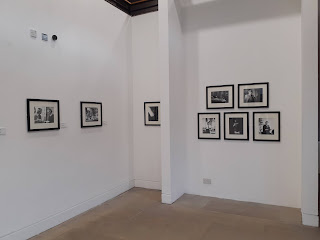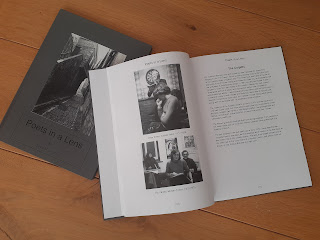In July my father, David M James died, at the age of 85. Some weeks later I joined my elder brother to help clear his house – a task that we have all learned to face with some dread. The clothes, furniture, the things we need for everyday life were all old, and could be disposed of with relative ease. But he left behind a huge collection of photographs and papers, and it was out of dealing with this large collection that I came to see my upbringing in a new light.
He had always been a man of varied interests. While professionally he had been a research scientist, and then a teacher, his interests had been wide – literature, music film, art, architecture, the living world. As we sorted through these papers, I found persistent reminders of the first sights of these things that he and my mother had provided. I can’t list them all, but as I looked through the collected playbills, programmes, and catalogues, I came to appreciate just how broad these introductions had been, and at what a young age. So, here was the catalogue for exhibitions of Futurism and Surrealism, in Newcastle and Durham. The programme for a cello recital by Paul Tortellier, violin by Yehudi Menhuin, plays from Shakespeare to John Arden, sculpture by Moore, and so on.
He also took me to poetry readings, an interest of his. Much earlier, at the age of eight or nine, I had lain upstairs unable to sleep, while my parents had entertained friends downstairs. It wasn’t a normal evening – they were to have an early meal, and then listen to a play on the radio. After dinner the adults gathered in our front room, and it was at that point that I crept downstairs in my dressing gown, complaining that I couldn’t sleep. It must have been 1963 or thereabouts. I was allowed to sit in the corner of our living room and listen to the broadcast of ‘Under Milk Wood’ by Dylan Thomas, very probably the original BBC version. I was captivated, and listened to the music of the words, even though I couldn’t understand a lot of it. (Why was there a gathering ? It's inconceivable now, getting together to listen to a radio broadcast ! Dad had a very fine vhf tuner, its green glowing valves driving big Wharfedale speakers. He was proud of it, so was there an element of showing off, both the technology and the knowledge that this would be a special event?)
So I was used to sitting still and being quiet, and listening to stuff that was hard to make sense of. I can’t remember my first trip to the Morden Tower, the unique poetry venue in Newcastle, but I do remember hearing Basil Bunting read Briggflatts there. The somewhat scruffy man arrived with his grip stencilled B. BUNTING, WYLAM, containing his collected poems and a half bottle of whisky. The first part of the evening covered shorter pieces, and then there was the reading of Briggflatts. As with the opening lines of Milk Wood, so with this poem – the hairs rose on my arms and neck, as the opening line ‘Brag, sweet tenor bull’ was delivered in the most musical Northumbrian brogue.
My father’s interests in photography and poetry merged, as he started to photograph the readings that he went to. He always gave the poets and other participants copies of the photos, and some were used in books and at exhibitions. Many have been donated to archives, the Basil Bunting archive in Durham, the Poetry Society, and many will go to the Morden Tower, which celebrates an anniversary this year.
So, as we worked on clearing the house, I found a ring binder with a short work about photographing poets and poetry readings. I remembered that he had tried to get it published, 20 years ago. Well, black and white photography of live poetry readings is a small subject area, unlikely to attract the interest of publishers. But I wondered…. Could I publish it myself, in blog form, as kind of thank you for the introduction he had give me? The chapters seem to be about the size of blog entries, but I have done it backwards so to speak – so it reads as a narrative down the blog. The photographs were scanned in, the words retyped, and some minor changes made to suit the format. I probably need to explain one aspect of the work. He loved photographing women, and he was surprisingly good at persuading them to pose for him, in varying stages of dress and undress. This explains some of the references in the text.
I have removed just two rather scathing references to individuals. Time has passed, and I have no wish to cause any offence to any who are pictured here. I have also removed a page of deeply technical information on photography, which is unlikely to be of interest due to changes in technology. It is possible that some of the pictures have been published before, but I have no reason to suppose that copyright has been infringed. If anyone does feel that they have copyright in any of the material presented, or that they would prefer not to have the photographs reproduced here, please contact me, and I will rectify the position.
Jeremy James, November 2008.




























































